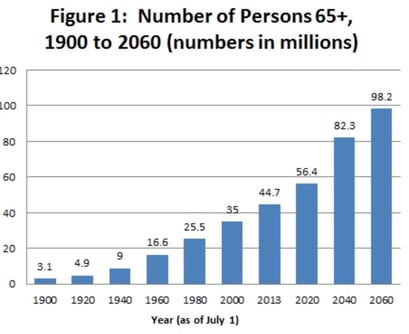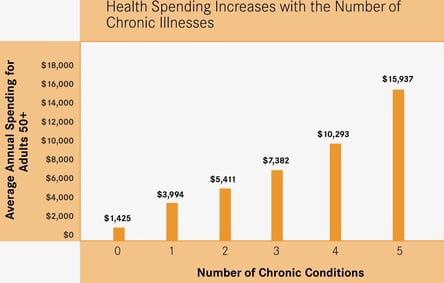 Have you ever heard of the "2030 Problem"? Well, the “2030 Problem” involves the challenge of assuring that sufficient resources and an effective healthcare system are available by the year 2030, when the elderly population is nearly twice what it is today. And, it's forecasted that this increase in population will have drastic affects on healthcare in the U.S.
Have you ever heard of the "2030 Problem"? Well, the “2030 Problem” involves the challenge of assuring that sufficient resources and an effective healthcare system are available by the year 2030, when the elderly population is nearly twice what it is today. And, it's forecasted that this increase in population will have drastic affects on healthcare in the U.S.
Over the next 50 years the expected growth of the older adult population will have an unprecedented impact on the health care system, especially in terms of the supply of and demand for primary care physicians.
Baby Boomers and Healthcare Spending
As of 2016, 3 million Baby Boomers will reach retirement age every year for the next fourteen years, and more than 71 million Americans will be 65 or older by 2030. This number will place a huge demand on the healthcare system in the country.

At this rate, every day 10,000 Baby Boomers become eligible for Medicare. And, 80% of this age group has one or more chronic condition.
Even though this generation may have a higher life-expectancy than previous generations, they still have a higher incidence of chronic disease, disability, and poor lifestyle choices, which force them to be in continual need for health support. As a result, they visit the emergency room and/or their primary care physician. However, with chronic conditions on the rise in this population, health care becomes more complex.
As the number of people with chronic conditions rises so does health care spending.
 For those older Americans with 3 chronic conditions, the average annual spending is $7,300. For those with 4 chronic conditions, the average annual spending is about $10,000. And, for those older Americans with 5 chronic conditions, the average annual spending is an astounding $16,000. And, it’s actually been calculated that chronic diseases account of 75 cents of every dollar spent on healthcare in America.
For those older Americans with 3 chronic conditions, the average annual spending is $7,300. For those with 4 chronic conditions, the average annual spending is about $10,000. And, for those older Americans with 5 chronic conditions, the average annual spending is an astounding $16,000. And, it’s actually been calculated that chronic diseases account of 75 cents of every dollar spent on healthcare in America.
And, its actually been found that nationally, 56%, or 67 million visits, are potentially avoidable. Many hospitals cannot handle the increased number of emergency patients but reducing this trend represents a significant opportunity to improve health care quality and lower costs for everyone because emergency room use costs vastly more than a visit to the primary care doctor.
The Baby Boomers and Primary Care
With the baby boomers representing 1/3 of the U.S. population, primary care is going to be hit with new challenges. Hospitals and other healthcare facilities, already limited with primary care physicians, will be facing even greater supply and demand problems.
As the American population ages and the prevalence of chronic conditions rise, the barriers between primary care physicians and their patients increase. Primary care physicians are already too busy and patients are unable to schedule timely appointments so the older Baby Boomers are bypassing primary care, since a same day appointment is but a memory of the past, and joining the stampede to the local hospital emergency room for non-urgent care problems that are treatable by primary care physicians. As a result, emergency departments are inundated, crippled, and some are even crushed.
What does this mean for YOU?
It means your tax dollars, rather than going towards the public school system to pay for our children’s education or the police force to pay for our daily protection, is going towards unnecessary health spending.
It means that even those who are currently insured will experience significant inconveniences and hassles. Everyone will encounter longer wait times, difficulty scheduling appointments, and less face-time with the doctor.
It means added stress on hospital resources, emergency room wait times, and an inefficient and lowered quality of care for those with true medical emergencies.
Luckily, there is a solution to the primary care crisis. The solution lies within direct primary care, which offers same-day appointment scheduling, longer appointments and increased access to care overall. For the cost of a monthly gym membership, you can help save primary care in the U.S. And, you'll save significant money in the longrun.

